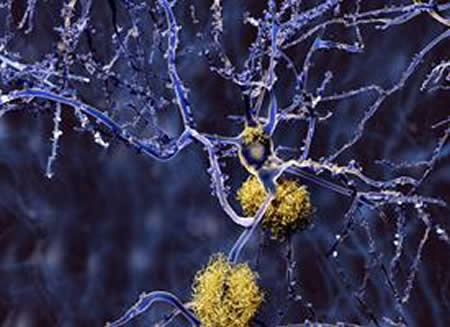A new study appearing in the Journal of Neuroinflammation suggests that the brain’s immune system could potentially be harnessed to help clear the amyloid plaques that are a hallmark of Alzheimer’s disease.
“This research confirms earlier observations that, when activated to fight inflammation, the brain’s immune system plays a role in the removal of amyloid beta,” said M. Kerry O’Banion, M.D., Ph.D., a professor in the University of Rochester Department of Neurobiology and Anatomy, the Del Monte Neuromedicine Institute, and the lead author of the study. “We have also demonstrated that the immune system can be manipulated in a manner that accelerates this process, potentially pointing to a new therapeutic approach to Alzheimer’s disease.”
The findings are the culmination of years of investigation that were triggered when O’Banion and his colleagues made a surprising discovery while studying mouse models of Alzheimer’s disease. They observed that amyloid beta plaques – which scientists believe play a major role in the disease – were being cleared in animals with chronic brain inflammation.

At the time, the mechanism by which the plaques were being removed was not clear. O’Banion and his colleagues eventually set their sights on microglia, native cells that serve as one the central nervous system’s first lines of defense against infection and injury. Microglia are present throughout the brain and spinal cord, are constantly monitoring their environment, and can be switched on or activated to perform different functions such as control inflammation, destroy pathogens, clean up the debris from dead or damaged cells, and seal off the site of an injury.
The researchers conducted a series of experiments to see if they could replicate the phenomenon of amyloid beta clearance absent brain inflammation. This required that they “trick” the microglia into action which was accomplished by injecting a specific protein molecule, a cytokine, into the brain. Cytokines play important roles in cell signaling and the researchers were able to replicate the mechanisms that instruct the microglia to activate an anti-inflammatory response.
Once the microglia were mobilized in mouse models of Alzheimer’s disease, the researchers observed a more than 60 percent reduction in amyloid beta in the brain.
“While we still need to fully understand the complexity and potential unintended consequences of this approach, it is clear that microglia play an important role in the removal of amyloid beta from the brain and may represent a novel approach to treating this disease,” said O’Banion.
Additional co-authors of the study include Jonathan Cherry, a Pathology graduate student now at Boston University, and John Olschowka with the University of Rochester. The research was supported by the National Institute of Aging.
Source: University of Rochester
Image Credit: The image is adapted from the University of Rochester press release
Original Research: Full open access research for “Arginase 1+ microglia reduce Aβ plaque deposition during IL-1β-dependent neuroinflammation” by Cherry JD, Olschowka JA and O’Banion MK in Journal of Neuroinflammation. Published online November 4 doi:10.1186/s12974-015-0411-8
Abstract
Arginase 1+ microglia reduce Aβ plaque deposition during IL-1β-dependent neuroinflammation
Background
Neuroinflammation has long been considered a driver of Alzheimer’s disease progression. However, experiments developed to explore the interaction between neuroinflammation and Alzheimer’s disease (AD) pathology showed a surprising reduction in amyloid beta (Aβ) plaque deposition. We sought to understand this unexpected outcome by examining microglia phenotypes during chronic neuroinflammation.
Methods
Using an adeno-associated virus vector carrying hIL-1β cDNA, inflammation was induced in one hippocampus of 8-month-old amyloid precursor protein (APP)/PS1 mice for 4 weeks, while the other hemisphere received control injections. Bone marrow chimeras and staining analysis were used to identify the origins and types of immune cells present during sustained inflammation. Arginase 1 (Arg1) and inducible nitric oxide synthase (iNOS) immunoreactivity were used as markers of alternatively activated and classically activated cells, respectively, and changes in cellular uptake of Aβ by Arg1+ or iNOS+ microglia was demonstrated by confocal microscopy. To determine if an anti-inflammatory phenotype was present during neuroinflammation, RNA was extracted on flow-sorted microglia and rt-PCR was performed. Interleukin-4 injection was used to induce alternatively activated cells, whereas a minipump and intrahippocampal cannula was used to deliver an interleukin (IL)-4Rα antibody to block the induction of Arg1+ cells in the setting of sustained IL-1β expression.
Results
We observed a robust upregulation of centrally derived Arg1+ microglia present only in the inflamed hemisphere. Furthermore, in the inflamed hemisphere, greater numbers of Arg1+ microglia contained Aβ when compared to iNOS+ microglia. RNA isolated from flow-sorted microglia from the inflamed hemisphere demonstrated elevation of mRNA species consistent with alternative activation as well as neuroprotective genes such as BDNF and IGF1. To explore if Arg1+ microglia mediated plaque reduction, we induced Arg1+ microglia with IL-4 and observed significant plaque clearance. Moreover, when we reduced Arg1+ microglia induction in the context of neuroinflammation using an anti-IL-4Rα antibody delivered via intrahippocampal cannula, we observed a clear correlation between numbers of Arg1+ microglia and plaque reduction.
Conclusions
Together, these findings suggest that Arg1+ microglia are involved in Aβ plaque reduction during sustained, IL-1β-dependent neuroinflammation, opening up possible new avenues for immunomodulatory therapy of AD.
“Arginase 1+ microglia reduce Aβ plaque deposition during IL-1β-dependent neuroinflammation” by Cherry JD, Olschowka JA and O’Banion MK in Journal of Neuroinflammation. Published online November 4 doi:10.1186/s12974-015-0411-8






